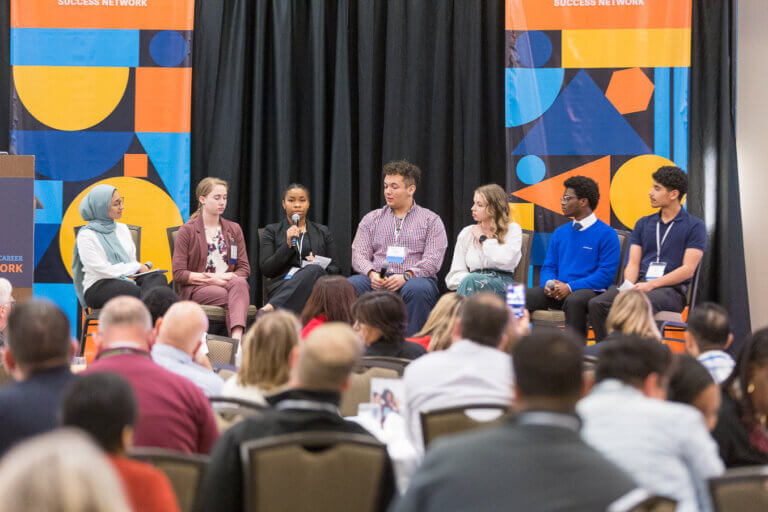Educators and employers often encounter a disconnect right where their spheres of effort should overlap: What is taught in the classroom doesn’t necessarily harmonize with what employers feel is required for new employees to be successful in the workplace. This represents a challenge that impacts the planning of courses, postsecondary decision-making, and hiring processes.
Addressing the Disconnect: The College and Career Pathway Endorsements and Competency Mapping Process
In July, 2016, Illinois took a bold step to improve transitions from high school into the next phases of life when it enacted the Postsecondary and Workforce Readiness Act (PWR Act). The PWR Act identified and addressed four ambitious components to improve the alignment and transition from high school to (and through) college and into careers. One is the College and Career Pathway Endorsements system. The endorsements are a cornerstone strategy of the PWR Act; development and implementation of the endorsements have brought together employers, higher education, K–12 leaders, and state agencies to collectively define the skills–or competencies–that students need for success in both college and career.
While the endorsement system is voluntary for school districts, the Illinois State Board of Education has incorporated it into its Every Student Succeeds Act (ESSA) College and Career Readiness Indicator as a method for substantially meeting all of the Indicator’s requirements. Currently, 16 Illinois communities–including over 90 high schools–are planning to start the implementation of College and Career Pathway Endorsements in the upcoming school year. The number of schools is certain to increase as ESSA is put into effect and more communities recognize the endorsement system as a useful structure for facilitating collaboration between local community colleges and employers. Through the endorsements, communities will plan pathway courses, industry credentials, and opportunities for professional learning.
Because the structures within educational institutions and employers are so different, the recently identified competencies can form a coherent common framework to bridge them. The endorsements define and strengthen their overlapping interests.
Over the past year, Education Systems Center at Northern Illinois University (EdSystems) has worked closely with JFF, a national nonprofit organization that drives transformation in the education and American workforce systems. Together, these facilitators spearheaded the collaborative and iterative process to define high-level competencies in four of the state’s seven college and career pathway endorsement areas by forming four state-wide public-private Steering Committees to define the 1) core employability competencies essential to all careers, and 2) the specific technical competencies helpful for planning in health sciences and technology; information technology; manufacturing and engineering; and finance and business services.
In consultation with state agencies and industry experts—including human resource professionals, education and training professionals, and industry associations—Illinois recently released a report detailing the College and Career Pathway Endorsements competencies that the steering committees have already developed in the four areas listed above. (Learn more at pwract.org.)
Why are these competencies important and innovative? In essence, they:
- Clearly describe both what students need to know and what they need to do across targeted industry sectors;
- Span and seamlessly connect learning across secondary and postsecondary education, providing content for designing pathways that span grades 9 through 12, with the hope of extending this into higher education;
- Provide employers and educators with a common language for and a shared understanding of the seven PWR Act endorsement areas and what they signify in the workplace; and
- Are designed for any time, anywhere applicability, reflecting that the PWR Act endorsements are earned through demonstrating competencies in classroom and workplace settings during work-based learning experiences.
JFF and EdSystems are now mapping the high-level competencies in the remaining three college and career pathway endorsement areas: agriculture, food, and natural resources; arts and communication; and education, as part of human and public services.
The Steering Committee and organizers are confident that the process that was codified to conduct this competency-mapping effort can serve as a helpful template for others to build upon across the country. The State has a vision that is reflected in the PWR Act–and now the State’s ESSA plan–that is both student-centered and employer-driven: a system of college and career pathways resulting from a collaboration between educators and employers so that all students will develop technical and essential employability competencies, earn in-demand credentials, and launch rewarding careers. Students who earn these endorsements will do just that.
Reinforcing a Local School District’s Initiatives: Belvidere School District 100
The College and Career Pathway Endorsements system is a mechanism that gives school districts a structure to validate students’ hard work to prepare for both college and career.
Almost ten years ago, the Belvidere School District 100 saw the real disconnect between the grades that students were receiving and the mastery of the skills associated with those grades. The district began a process to unpack the standards associated with each class, identifying criteria for learning. This led to the development of proficiency scales which create a much more personalized approach to grading, allowing teachers to communicate with students more directly about skills attainment.
The College and Career Pathway Endorsements system provided a very exciting way for the district to connect the local work they are doing to the efforts of other communities across Illinois. “Preparing students for ‘what’s next’ has always been the goal of educators. The endorsement framework provides us with a structure to do that, and the competencies developed by employers through the work of EdSystems and others ensure what we are teaching is aligned to the current needs of industry,” says Nik Buttenhof, Director of Career Readiness, Belvidere School District 100.


